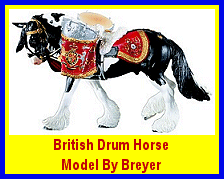 | Other Names: Drum Horse Origin: British Isles Color: Traditionally, drum horses are nearly always spotted-- usually black or bay tobiano with a rare sabino popping up occasionally. Frame and splash overo patterns are not native to the British Isles, and so they have not been seen in the drum horse. Avg Height: 16.0 hh and over |
Avg Weight: Varies
Build: Usually heavy boned and feathered. Varies.
Temperament: Incredibly good temperament, as they must handle parades and public well.
Main use: British Drum Horses are used by the remaining ceremonial British cavalry as part of their regimental band. As their name suggests, these horses carry two kettle drums--plus a rider--during the Royal Parades. Because the drums are made of solid silver, these Drum horses must be big and powerful to carry this great weight.
Special abilities: The drummers control the horses with reins attached to their feet. For this reason, horses used in the regimental band must be mature and even-tempered with the patience to stand in place for long periods of time.
For Breeders, Farms, and Studs of this breed, click here.
If you have a horse of this breed, and you would like to see your pictures posted here, or if you would like to advertise your business that involves this particular breed, you can also email me.
I'm not perfect, and I never claim to be! If you see anything here that you believe I am wrong about, please feel free to email me. I might not agree with you, but at least I will listen!! :0) Can you fill in any of my blanks? Do you know of information or links that you would like to share with draft animal enthusiasts that you don't see here? Am I missing anything? Let me know at Draftladyb@yahoo.com.